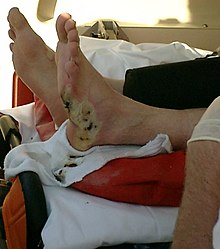Signs and symptoms
Burns
Second-degree burn after a high tension line accident
Ventricular fibrillation
A domestic power supply voltage (110 or 230 V), 50 or 60 Hz AC current through the chest for a fraction of a second may induce ventricular fibrillation at currents as low as 60 mA. With DC, 300 to 500 mA is required.[2] If the current has a direct pathway to the heart (e.g., via a cardiac catheter or other kind of electrode), a much lower current of less than 1 mA (AC or DC) can cause fibrillation. If not immediately treated by defibrillation, fibrillations are usually lethal because all the heart muscle cells move independently instead of in the coordinated pulses needed to pump blood to maintain circulation. Above 200 mA, muscle contractions are so strong that the heart muscles cannot move at all.Neurological effects
Current can cause interference with nervous control, especially over the heart and lungs. Repeated or severe electric shock which does not lead to death has been shown to cause neuropathy. Recent research has found that functional differences in neural activation during spatial working memory and implicit learning oculomotor tasks have been identified in electrical shock victims.[6]When the current path is through the head, it appears that, with sufficient current,[clarification needed] loss of consciousness almost always occurs swiftly. (This is borne out by some limited self-experimentation by early designers of the electric chair[citation needed] and by research from the field of animal husbandry, where electric stunning has been extensively studied.)[7]

No comments:
Post a Comment